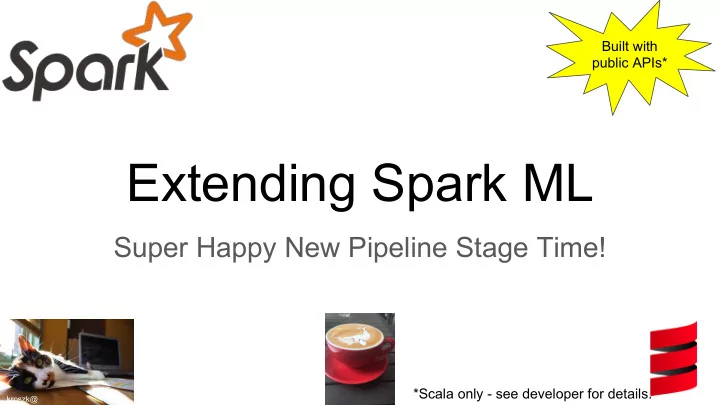

Built with public APIs* Extending Spark ML Super Happy New Pipeline Stage Time! *Scala only - see developer for details. kroszk@
Who am I? ● My name is Holden Karau ● Prefered pronouns are she/her ● I’m a Principal Software Engineer at IBM’s Spark Technology Center ● previously Alpine, Databricks, Google, Foursquare & Amazon ● co-author of Learning Spark & Fast Data processing with Spark ○ co-author of a new book focused on Spark performance coming this year* ● @holdenkarau ● Slide share http://www.slideshare.net/hkarau ● Linkedin https://www.linkedin.com/in/holdenkarau ● Github https://github.com/holdenk ● Spark Videos http://bit.ly/holdenSparkVideos
What are we going to talk about? ● What Spark ML pipelines look like ● What Estimators and Transformers are ● How to implement a Transformer - and what else you will need to do to make an estimator ● I will of course try and sell you many copies of my new book if you have an expense account.
Spark ML pipelines ● In the batch setting, an estimator is trained on a dataset, and produces a static, immutable transformer. Estimator Tokenizer HashingTF String Indexer Naive Bayes fit(df) Transformer Streaming Streaming Tokenizer HashingTF String Indexer Naive Bayes
So what does a pipeline stage look like? Wendy Piersall Are either an: ● Estimator - no need to train can directly transform (e.g. HashingTF) (with transform) ● Transformer - has a method called “fit” which returns an estimator Must provide: ● transformSchema (used to validate input schema is reasonable) & copy Often have: ● Special params for configuration (so we can do meta-algorithms)
Walking through a simple transformer: Mário Macedo class HardCodedWordCountStage ( override val uid : String ) extends Transformer { def this () = this ( Identifiable .randomUID("hardcodedwordcount")) def copy(extra : ParamMap ) : HardCodedWordCountStage = { defaultCopy(extra) }
Verify the input schema is reasonable: override def transformSchema(schema : StructType ) : StructType = { // Check that the input type is a string val idx = schema.fieldIndex("happy_pandas") val field = schema.fields(idx) if (field.dataType != StringType ) { throw new Exception (s"Input type ${ field.dataType } did not match input type StringType") } // Add the return field schema.add( StructField ("happy_panda_counts", IntegerType , false )) }
Do the “work” (e.g. predict labels or w/e): vic15 def transform(df : Dataset [ _ ]) : DataFrame = { val wordcount = udf { in : String => in.split(" ").size } df.select(col("*"), wordcount(df.col("happy_pandas")).as("happy_panda_counts")) }
What about configuring our stage? Jason Wesley Upton class ConfigurableWordCount ( override val uid : String ) extends Transformer { final val inputCol = new Param [ String ]( this , "inputCol", "The input column") final val outputCol = new Param [ String ]( this , "outputCol", "The output column") def setInputCol(value : String ) : this.type = set(inputCol, value) def setOutputCol(value : String ) : this.type = set(outputCol, value)
So why do we configure it that way? Tricia Hall ● Allow meta algorithms to work on it ● If you like inside of spark you’ll see “sharedParams” for common params (like input column) ● We can access those unless we pretend to be inside of org.apache.spark - so we have to make our own
So how to make an estimator? sneakerdog ● Very similar, instead of directly providing transform provide a `fit` which returns a “model” which implements the estimator interface as shown above ● We could look at one - but I’m only supposed to talk for 10 minutes ● So keep an eye out for my blog post in November :) ● Also take a look at the algorithms in Spark itself (helpful traits you can mixin to take care of many common things).
Resources to continue with: Captain Pancakes ● O’Reilly Radar (“Ideas”) Blog Post http://bit.ly/extendSparkML ● High Performance Spark Example Repo has some sample “custom” models https://github.com/high-performance-spark/high-performance-spark-examples ○ Of course buy several copies of the book - it is the gift of the season :p ● The models inside of Spark its self: https://github.com/apache/spark/tree/master/mllib/src/main/scala/org/apache/ spark/ml (use some internal APIs but a good starting point) ● As always the Spark API documentation: http://spark.apache.org/docs/latest/api/scala/index.html#org.apache.spark.pac kage ● My Slide share http://www.slideshare.net/hkarau
Fast Data Coming soon: Learning Spark Processing with Spark in Action Spark (2nd edition) Fast Data Processing with Advanced Spark Coming soon: Analytics with (Out of Date) High Performance Spark Spark
The next book….. First seven chapters are available in “Early Release”*: ● Buy from O’Reilly - http://bit.ly/highPerfSpark ● Extending ML is covered in Chapter 9 :) Get notified when updated & finished: ● http://www.highperformancespark.com ● https://twitter.com/highperfspark * Early Release means extra mistakes, but also a chance to help us make a more awesome book.
Any PySpark Users: Have some k thnx bye :) simple UDFs you wish ran faster you are willing to share?: http://bit.ly/pySparkUDF Will tweet results “eventually” @holdenkarau If you care about Spark testing and don’t hate surveys: http://bit.ly/holdenTestingSpark Pssst: Have feedback on the presentation? Give me a shout (holden@pigscanfly.ca) if you feel comfortable doing so :)
Recommend
More recommend